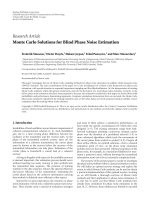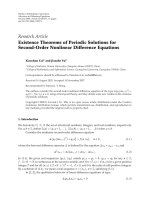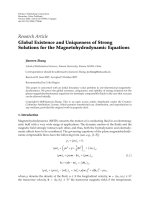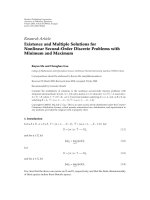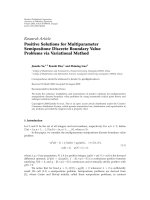FORTINET SOLUTIONS FOR CMMC COMPARISON MATRIX
Bạn đang xem bản rút gọn của tài liệu. Xem và tải ngay bản đầy đủ của tài liệu tại đây (682.33 KB, 11 trang )
<span class="text_page_counter">Trang 2</span><div class="page_container" data-page="2">
Cybersecurity Maturity Model Certification
The Cybersecurity Maturity Model Certification (CMMC) is intended as a comprehensive framework for how cybersecurity solutions are implemented across more than 300,000 companies involved in the U.S. defense industrial base supply chain. CMMC v1.01 was released on January 31, 2020, and is the U.S. Department of Defense’s (DoD) stepped-up requirement for keeping DoD information accessed by or housed in contractors’ technology environments secure.
Previously, contractors supporting DoD had responsibility for assessing and self-certifying their success implementation, monitoring, and maintaining the security of any sensitive DoD information stored or accessible from their IT systems. The big change with CMMC is that the DoD will require third-party-governed assessments of how those contractors comply with best practices intended to protect data from cyber adversaries and prevent successful breaches. Details on how assessments will be conducted are still forthcoming as of July 2020, but all DoD contractors must understand the CMMC’s technical requirements and prepare for certification, or risk eligibility to participate in DoD contracts, each of which will be tied to one or more CMMC levels.
Specifically, CMMC includes five certification levels intended to highlight a company’s cybersecurity maturity and resilience levels—and therefore, a reflection of how effectively it can protect sensitive government information. Fortinet solutions for government are well-positioned to meet CMMC standards at all levels.
</div><span class="text_page_counter">Trang 3</span><div class="page_container" data-page="3"><b>CMMC Capability PracticesFortinet Solution</b>
<b>Fortinet Consulting Service</b>
Fortinet consulting service team can help customers develop security plans to meet requirements as applicable to NIST 800-53, 800-171, and CSF.
FortiGates running FortiOS 6.4 now support Network access control (NAC) helps administrators implement policies to control the devices and users that have access to their networks. A NAC policy can use user or detected device information, such as device type or OS, to put traffic into a specific VLAN or apply specific port settings. FortiGate also supports a customizable captive portal per-interface and per-policy, which can be configured with custom disclaimers for privacy and security notices.
FortiNAC assists with bring-your-own-device (BYOD) policies and a means to safely accommodate headless IoT devices in the network. FortiNAC enables three key capabilities to secure IoT devices:
FortiGate identity and application aware policies limit activity between authorized users and applications to only permitted activity. FortiGate can also capture packets and other forensic data when a violation occurs. FortiGate device-based policies control how mobile device connect and where they can go on the network.
Fortinet wireless technologies can deploy DTLS to encrypt the data channel and EAP-TLS to provide PKI authentication between Wi-Fi clients and authentication server.
FortiGate wireless technologies can perform monitoring of rogue APs and actively prevent users from connecting to them. When suppression is activated against an AP, the FortiGate WiFi controller sends deauthentication messages to the rogue AP’s clients, posing as the rogue AP, and also sends deauthentication messages to the rogue AP, posing as its clients.
FortiNAC assists with bring-your-own-device (BYOD) policies and limit where devices can go on the network.
FortiSIEM provides complete detail of user’s access to resources from across all devices and applications.
FortiAuthenticator account policies can enable user account lockout for failed login attempts based on maximum number of allowed failed attempts. FortiAuthenticator account policies can terminate sessions after organization-defined periods of user inactivity, targeted responses to certain types of incidents, time-of-day restrictions on information system use.
</div><span class="text_page_counter">Trang 4</span><div class="page_container" data-page="4"><b>COMPARISON MATRIX | </b>Fortinet Solutions for CMMC
<b>CMMC Capability PracticesFortinet Solution</b>
FortiGate as the remote access concentrator manages all sessions and can provide layer 7 inspection over all activity from remote access users to protected resources. The FortiGate operating system, FortiOS, undergoes FIPS validation for every minor release. Additionally, all FortiGate models are FIPS affirmed so customers have the ability to choose any model in the portfolio. The FIPS validated crypto is used in both management and data plane communications e.g. HTTPS, IPSec VPN, SSL VPN, etc. FortiGate as the remote access concentrator includes the ability to execute remote user posture validation and take into account users’ risk factors from external threat intelligence sources. FortiGate supports AAA to strictly define the commands that users are authorized to access. FortiGate dynamic DNS allows customers to advertise remote access control points easily to remote users.
Limit data access to authorized users and processes
AC.1.003, AC.1.004, AC.2.016
FortiGate identity and application aware policies limit activity between authorized users and external applications to only permitted activity. FortiGate data leak prevention can ensure that CUI does not get transmitted in unauthorized flows.
Manage asset inventory
FortiGate device inventory allows FortiOS to monitor networks and gather information about devices operating on those networks, including MAC and IP addresses, operating systems, hostnames, and usernames.
FortiGate device inventory allows FortiOS to monitor networks and gather information about devices operating on those networks, including MAC and IP addresses, operating systems, hostnames, and usernames.
Define audit requirements
AU.2.041, AU.3.046 <b><sub>FortiGate</sub></b>
FortiGate logs individual activities to the system event log.
FortiAuthenticator can identify network users, processes on systems to be used for non-repudiation accountability tasks.
FortiGate can leverage authenticated and trusted NTP servers to synchronize internal clocks for audit log time stamping.
FortiSIEM is a central repository of all audit logs for systems and endpoints allowing administrators to leverage the automated correlation of activity to determine unlawful or unauthorized activity. FortiSIEM can alert if any systems report a failure on audit logging processes
Identify and protect audit information
AU.3.049, AU.3.050 <b><sub>FortiGate</sub></b>
Audit tool configuration and files are not modifiable by system users. System users are only granted access to modify their view of the tools’ outputs.
FortiSIEM role-based access control (RBAC) can granularly specify which users have access to which information.
</div><span class="text_page_counter">Trang 5</span><div class="page_container" data-page="5"><b>CMMC Capability PracticesFortinet Solution</b>
FortiSIEM is a central repository of all audit logs for systems and endpoints allowing administrators to leverage the automated correlation of activity to determine unlawful or unauthorized activity. FortiSIEM provides an easy reporting interface that makes reviewing audit information from all systems on the network very easy.
Conduct training
Fortinet NSE Training enables personnel from novice to senior level to learn how to execute duties related to infosec daily operation, incident handling, and service
<b>Fortinet Security Fabric Products</b>
Fortinet products support role-based access that specifies exactly what each user can execute in order to enable a least-privilege posture.
FortiSIEM CMDB collects and maintains the baseline configurations and inventories of all endpoints. The CMDB can be used to provide real-time alerts to changes and report on changes throughout system lifecycles.
<b>FortiClient/FortiClient EMS</b>
FortiClient Software Inventory Management provides visibility into installed software applications and license management to improve security hygiene. You can use inventory information to detect and remove unnecessary or outdated applications that might have vulnerabilities to reduce your attack surface.
FortiClient Software Inventory Management provides visibility into installed software applications and license management to improve security hygiene. You can use inventory information to detect and remove unnecessary or outdated applications that might have vulnerabilities to reduce your attack surface.
FortiEDR delivers the most advanced automated attack surface policy control with vulnerability assessments and discovery that allows security teams to:
FortiAuthenticator can identify users through a varied range of methods and integrate with third-party LDAP or Active Directory systems to apply group or role data to the user and communicate with FortiGate for use in Identity- based policies. Additionally, FortiAuthenticator could also be used for 802.1X implementations with Fortinet and 3rd party network devices. FortiAuthenticator extends two-factor authentication capability to multiple FortiGate appliances and to third party solutions that support RADIUS or LDAP authentication. FortiAuthenticator user account policies provide restrictions on password complexity and password reuse. FortiAuthenticator can discard stale authentication requests to prevent replay
</div><span class="text_page_counter">Trang 6</span><div class="page_container" data-page="6"><b>COMPARISON MATRIX | </b>Fortinet Solutions for CMMC
<b>CMMC Capability PracticesFortinet Solution</b>
attacks. FortiAuthenticator user database can allow for a temporary password requiring an immediate change to a permanent and confidential password. FortiAuthenticator stored password data is cryptographically hashed and salted. Transmitted password data can be protected by using the secure versions of authentication protocols e.g. LDAPS.
FortiToken combines user identity information from FortiAuthenticator and ensures that only authorized individuals are granted access to designated resources.
FortiSOAR facilitates efficient investigation of alerts through automated workflows, that can include manual intervention, allowing security analysts to neutralize threats quickly and gain visibility into the bigger picture and understand trends. FortiSOAR aggregates these alerts in one place while enriching them with added context to speed investigations. FortiSOAR streamlines simple SOC tasks such as alert ingestion, prioritization based on severity levels, assigning tasks, and subroutines and automates more complex exchange-to-exchange (E2E) tasks, such as triage, enrichment, investigation, and remediation, cohesively centralizing the security processes by automatically correlating alerts from across a security stack into a single incident.
Detect and report events
IR.2.093, IR.2.094 <b><sub>Fortinet Security Fabric Products </sub></b>
Fortinet Security Fabric products provide advanced inspection capabilities to detect and report on interesting events.
FortiSOAR aggregates these alerts in one place while enriching them with added context to speed investigations. FortiSOAR streamlines simple SOC tasks such as alert ingestion, prioritization based on severity levels, assigning tasks, and subroutines and automates more complex exchange-to-exchange (E2E) tasks, such as triage, enrichment, investigation, and remediation, cohesively centralizing the security processes by automatically correlating alerts from across a security stack into a single incident.
FortiSOAR facilitates efficient investigation of alerts through automated workflows, that can include manual intervention, allowing security analysts to neutralize threats quickly and gain visibility into the bigger picture and understand trends. FortiSOAR aggregates incident alerts in one place while enriching them with added context to accelerate time to resolution. It also helps reduce the number of “false-positive” alerts and provides advanced case management functions that help to define, guide, and speed investigations. All activities can be reported to designated individuals or organizations. FortiSOAR simplifies SOC complexity by integrating disparate point security solutions into a centralized orchestration system that can be deployed in virtually any environment. This enables even the smallest of SOC teams to centralize their entire security process and to respond with all their current tools, which results in faster real-time response.
Perform post incident reviews
FortiSOAR aggregates these alerts in one place while enriching them with added context to speed investigations. FortiSOAR streamlines simple SOC tasks such as alert ingestion, prioritization based on severity levels, assigning tasks, and subroutines and automates more complex exchange-to-exchange (E2E) tasks, such as triage, enrichment, investigation, and remediation, cohesively centralizing the security processes by automatically correlating alerts from across a security stack into a single incident.
</div><span class="text_page_counter">Trang 7</span><div class="page_container" data-page="7"><b>CMMC Capability PracticesFortinet Solution</b>
Manage maintenance
MA.2.111, MA.2.112, MA.2.113, MA.3.115
<b>Fortinet Security Fabric Products</b>
Fortinet maintenance capabilities allow for direct or centrally managed maintenance operations. Fortinet devices support role-based access control to ensure that only authorized personnel can perform maintenance on Fortinet systems. Fortinet devices support deleting CUI data and defined overwrites to sanitize devices of CUI.
FortiGate remote access VPNs support native multifactor authentication to include but not limited to one-time password (OTP) tokens and user certificates with PKI, CAC, or PIV. FortiGate can also integrate with external authentication platforms that are integrated with additional authentication repositories.
The service encompasses everything needed to implement two-factor
authentication in the FortiGate environment including the FortiToken Mobile app with push technology, simplifying the end-user two-factor experience to a swipe or click to accept.
Sanitize media
Fortinet Secure RMA service supports customers that cannot return replaced hardware due to physical data protection requirements.
Manage backups
FortiManager performs regular and incremental backups of FortiGate configurations allowing FortiGates to be restored with ease.
FortiAnalyzer performs regular backups of traffic logs and network audit data. These backups can also be rolled and archived to long-term storage over the network.
Manage information security continuity
RE.5.140 <b>Fortinet Security Fabric Products</b>
Fortinet Security Fabric Products support many configurations that enable high-availability and continuity.
<b>Fortinet Security Fabric </b>
Fortinet security devices are designed to allow sharing of IOCs with each other and 3rd party tools, as well as leverage IOCs from external resources.
FortiSandbox displays malware techniques and tactics cross-referenced with the MITRE ATT&CK matrix to enable analysts to quickly familiarize with adversary methodologies.
<b>FortiGuard Penetration Testing Service</b>
FortiGuard Pentest Team offers assessments of external and internal vulnerabilities, and web and mobile applications penetration testing. The team also provide as a report of security shortfalls in the network and provides guidance on remediation procedures.
Manage risk
RM.3.146, RM.5.155 <b>FortiGuard Penetration Testing Service</b>
FortiGuard Pentest Team offers assessments of external and internal vulnerabilities, and web and mobile applications penetration testing. The team also provide as a report of security shortfalls in the network and provides guidance on remediation procedures.
</div><span class="text_page_counter">Trang 8</span><div class="page_container" data-page="8"><b>COMPARISON MATRIX | </b>Fortinet Solutions for CMMC
<b>CMMC Capability PracticesFortinet Solution</b>
Develop and manage a system security plan
CA.2.157, CA.4.163 <b>Fortinet Consulting Service</b>
Fortinet consulting service team can help customers develop security plans to meet requirements as applicable to NIST 800-53, 800-171, and CSF.
<b>Fortinet Consulting Service</b>
Fortinet consulting service team can help customers assess security control effectiveness in meeting requirements as applicable to NIST 800-53, 800-171, and CSF.
<b>FortiGuard Penetration Testing Service</b>
FortiGuard Pentest Team offers assessments of external and internal
vulnerabilities, and web and mobile applications penetration testing. The team also provide as a report of security shortfalls in the network and provides guidance on remediation procedures.
Perform code reviews
CA.3.162 <b>FortiGuard Penetration Testing Service</b>
FortiGuard Pentest Team offers assessments of external and internal
vulnerabilities, and web and mobile applications penetration testing. The team also provide as a report of security shortfalls in the network and provides guidance on
<b>Fortinet Security Fabric Devices</b>
Fortinet Security Fabric devices store CUI data on encrypted storage.
The FortiGate operating system, FortiOS, undergoes FIPS validation for every minor release. Additionally, all FortiGate models are FIPS affirmed so customers have the ability to choose any model in the portfolio. FortiGate can be deployed to provide isolation on any segment of the network. This flexibility is due to the FortiGate ability to operate as both a layer 2 and layer 3 segmentation firewall. FortiGate Security Rating audits the network configuration to ensure that CIS controls are adhered to in the design. The FortiGate layer 7 inspection can prohibit remote activation of collaborative applications to any device. FortiGate can record packets that trigger firewall rules or security inspection matches. The FortiGate VPN for site-to-site and remote-access users can provide the security required for management of network devices. FortiGate can prevent split tunneling and force all communication from remote SSL VPN users including traffic to the Internet uses an SSL VPN tunnel between the user’s PC and the FortiGate unit. Connections to the Internet are routed back out the FortiGate unit to the Internet. Replies from the internet come back into the FortiGate unit before being routed back through the SSL VPN tunnel to the remote user. FortiGate enforces strict compliance with ports and protocols as both a layer 2 and layer 3 segmentation firewall. FortiGate can logically or physically isolate management plane and data plane functionality within the system with role-based access control and through the system with virtual domain (VDOM) technology. FortiGate Data Leak Prevention (DLP) can be used to define sensitive data patterns, and data matching these patterns will be blocked, or logged and allowed, when passing through the FortiGate unit. FortiGate session idle timers can be configured close communications after inactivity on a per port or application basis providing granular control of network behavior. The FortiGate allows for cryptographic key management from the central management system, FortiManager, and directly on the FortiGate via GUI, CLI, and API with automated 3rd party DevOps tools. FortiGate Mobile Security Service employs advanced detection engines to prevent both new and evolving threats from gaining a foothold inside your network and gaining access to its invaluable information. FortiGate offers advanced VOIP protection and performs Deep SIP message inspection for SIP statements. FortiGate mechanisms such as strict-header checking for anti-spoofing protection and certificate inspection ensure that illegitimate entities are not communicated through the device.
</div><span class="text_page_counter">Trang 9</span><div class="page_container" data-page="9"><b>CMMC Capability PracticesFortinet Solution</b>
FortiClient thick client VPN enables SSL and IPsec VPN to manage network devices over the network.
<b>Fortinet Security Fabric Products</b>
Fortinet security devices are designed to allow sharing of IOCs with each other and 3rd party tools, as well as leverage IOCs from external resources. Fortinet security devices can also communicate to stakeholders when new IOCs are received.
FortiGate automation stitches can dynamically respond to IOCs received from external resources.
<b>FortiSIEM with FortiInsight Subscription</b>
Powered by its discovery capabilities, FortiSIEM can seamlessly collect a rich variety of performance and availability metrics to help the investigator hunt for threats from zero day malware. FortiSIEM can also alert when the metrics are outside of normal profile and can correlate such violations with security issues to create high fidelity alerts. FortiSIEM remediation scripts are out-of-the-box tools to automate response to IOCs with Fortinet or 3rd party security tools.
FortiInsight provides rich access to the record of events that are streaming in from endpoints. Analysts are able to investigate events using broad search or summary tables to find more detailed information about events.
FortiGates filter network traffic to protect an organization from external threats. Features include stateful packet filtering, network monitoring, IP mapping features, and deep inspection to identify attacks, malware, and other threats. FortiGate can be deployed to create subnetwork and isolate them from any segment of the network. This flexibility is due to the FortiGate ability to operate as both a layer 2 and layer 3 segmentation firewall. FortiOS Web Filtering solution utilizes FortiGuard Web Filtering Services with superior coverage of over 250 million rated websites. The FortiGate DNS filter can allow, block, or monitor access to web content according to FortiGuard categories. Once organizational policy is defined, FortiGate Data Leak Prevention (DLP) can be used to define sensitive data patterns, and data matching these patterns will be blocked, or logged and allowed, when passing through the FortiGate unit. The FortiGate natively uses the FortiGuard threat intelligence database containing a list of known malicious domains, botnet command and control (C&C) addresses. This database is updated dynamically and stored on the FortiGate. FortiGate can be used to protect internally defined boundaries and automation stitches to dynamically prevent threat identified by organizational personnel. FortiGate Mobile Security Service employs advanced detection engines to prevent both new and evolving threats. FortiGate can also leverage FortiSandbox for further analysis.
</div><span class="text_page_counter">Trang 10</span><div class="page_container" data-page="10"><b>COMPARISON MATRIX | </b>Fortinet Solutions for CMMC
<b>CMMC Capability PracticesFortinet Solution</b>
FortiSandbox improves zero-day threat detection efficacy and performance by leveraging two machine learning models—patent-pending enhanced random forest with boost tree and least squares optimization applied to static and
dynamic analysis of suspicious objects. It also accelerates threat investigation and management processes by adopting standards-based on the MITRE ATT&CK framework for malware reporting.
The Fortinet automated breach protection strategy enables FortiSandbox to easily integrate across both Fortinet and non-Fortinet products to provide real-time threat intelligence and speed threat response.
FortiSandbox analysis also includes malware that targets industrial control systems (ICS) so it can deliver the same sandbox benefits to organizations that manage both Information Technology (IT) and Operation Technology (OT) business segments.
Identify and manage information system flaws
SI.2.214, SI.4.221 <b>Fortinet Consulting Service</b>
Fortinet security devices are designed to allow sharing of IOCs with each other and 3rd party tools, as well as leverage IOCs from external resources.
FortiSIEM remediation scripts are out-of-the-box tools to automate response to IOCs with Fortinet or 3rd party security tools.
FortiGate Antivirus protects against the latest viruses, spyware, and other content-level threats. It uses industry-leading advanced detection engines to prevent both new and evolving threats from gaining a foothold inside your network and accessing its invaluable content. FortiGate antivirus keeps protections up-to-date with hourly push updates. Updates may also be manually uploaded in air-gapped networks. FortiGate can apply antivirus protection to HTTP, FTP, IMAP, POP3, SMTP, and NNTP sessions, and with SSL/SSH content scanning and inspection, FortiGate can also configure antivirus protection for HTTPS, IMAPS, POP3S, SMTPS, and FTPS sessions.
Powered by its discovery capabilities, FortiSIEM can seamlessly collect a rich variety of performance and availability metrics to help the investigator hunt for threats from zero day malware. FortiSIEM can also alert when the metrics are outside of normal profile and can correlate such violations with security issues to create high fidelity alerts.
FortiGate can be deployed to provide isolation on any segment of the network. FortiGate layer 7 inspection capabilities provide insight into payloads that allow detection potential attacks and indicators of compromise. FortiGate email filtering techniques use FortiGuard services to detect the presence of spam among your email. Capabilities include:
</div>


